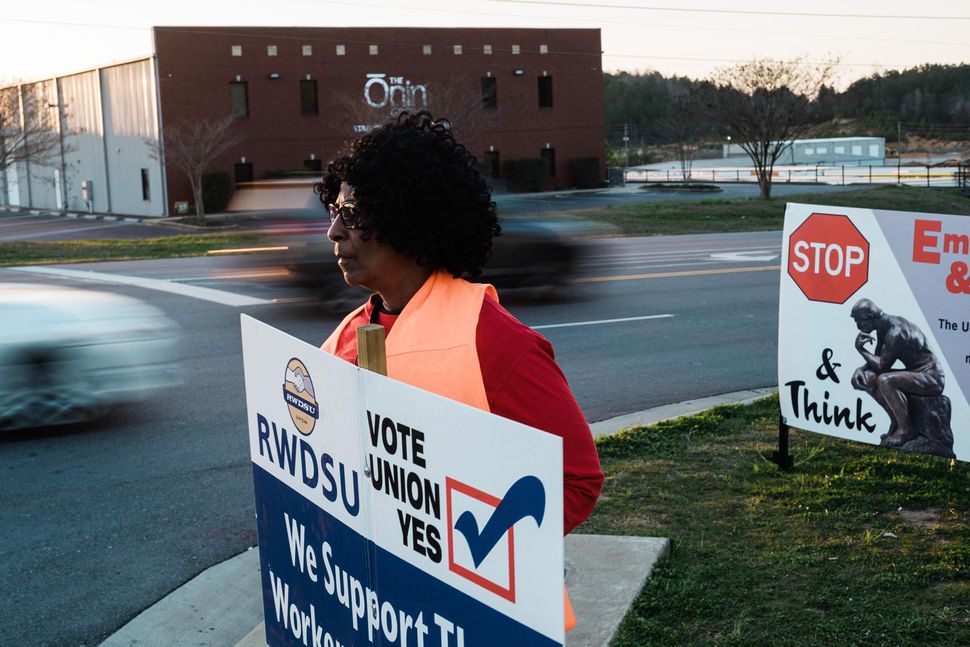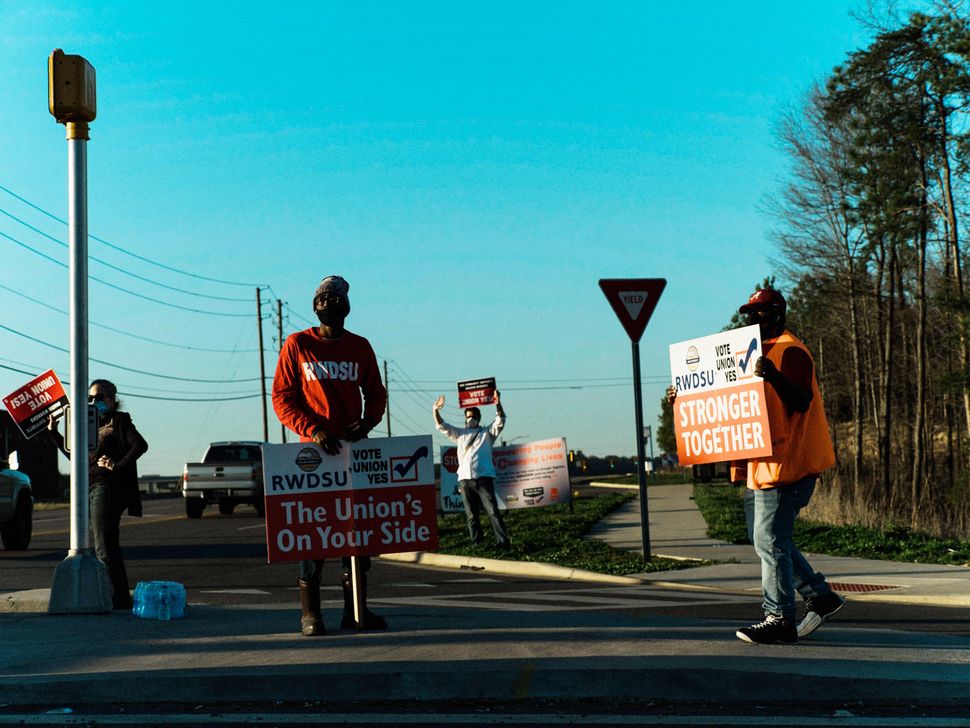The Battle To Unionize Amazon’s Alabama Warehouse Started Right Here
BESSEMER, Ala. ― The most closely watched union campaign in years began at the entrances to an Amazon warehouse here last October. Five months later, workers and organizers are still standing at the same posts day and night, determined not to let up until the ballots are counted at the end of March.
If the Retail, Wholesale, and Department Store Union wins this fight to create the first union within Amazon’s U.S. workforce, the victory will have been seeded right here.
“Every gate is really important. It’s how you start organizing,” said José Aguilar, a union representative stationed at an entrance one day last week.
Aguilar, 48, was working the evening shift as the sun set and the temperature hung near 70 degrees ― the most pleasant weather he could ask for while standing on a sidewalk for a few hours. He held a union sign and waved as a worker leaving the parking lot pulled up to the traffic light, headed home. Aguilar’s colleagues stood at two other spots down the road.
He tried to explain why he’s stood at the entrances since the fall, sometimes for 10 consecutive days.
“If [workers] stop and have questions, we answer the questions,” Aguilar said. “If they come and we left, and they don’t see nobody, they’re gonna say, ‘They don’t care.’”

Posting workers and organizers at the facility gates is a standard feature of industrial organizing campaigns, since unions don’t have access to worksites and don’t receive workers’ contact information until an election is scheduled. That means having to approach workers on public property right outside to make the case for why they should organize.
The entrance is where organizers amassed many of the 3,000 union cards workers signed. Signing a card indicates you authorize the union to represent you, but in reality it just means you’re game for a secret-ballot election. Once a union gathers cards from 30% of the expected bargaining unit, it can trigger an election through the National Labor Relations Board, though unions typically try to gather a greater share, to be more confident they have majority support.
The entrance is also where union organizers built trust and relationships with workers coming and going from the warehouse. And it’s where they endured frigid temperatures, the occasional cussing, and a lot of boredom between warehouse shift changes.
The RWDSU’s work at the gates has been unusually important for this campaign, given the size of the potential bargaining unit. With 5,800 workers, it appears to be the biggest union election under the National Labor Relations Board in two decades. Their conversations have also been a crucial source of intelligence on Amazon’s anti-union campaign unfolding inside the facility.
Mona Darby, 63, said she has spent so much time interacting with workers at the entrances that she knows which ones would make good union reps if the RWDSU wins. She said some workers will specifically ask to see “Ms. Mona” on their way out.
“You remember the cars. You remember the faces,” said Darby, who works as an inspector at a poultry plant a few hours away and serves as the president of her union local. “Certain ones stop by all the time to talk to you. If the light changes [green], they’ll keep going and holler at you.”

Working the entrances takes backbone. Darby said one particular man leaving the facility ― “the white guy in the truck” ― often heckles them. There have been times when someone would pull up in a car, post up across the street at night and watch the organizers in silence. Early on in the campaign, she said, a white man told her he didn’t want her “Black ass” around the warehouse.
Joshua Brewer, the RWDSU’s lead organizer for the Amazon campaign, said the union made a strategic decision early on to never leave their spots ― except for Christmas Day. At first, union members and organizers held the posts around the clock, so that no worker left the facility without passing them.
Several of the union members who are organizing work in poultry plants, and they wore industrial freezer gear to battle temperatures that dropped into the teens. Warehouse workers could see them jumping around to stay warm. Eventually, the union pulled back on the midshift hours, when they were unlikely to encounter much traffic.
Brewer, who spent many days at the entrances himself, said there is a fine line between showing dedication and looking a little sad.
“We didn’t want the workers worrying about us,” he said with a laugh.
In Brewer’s office in downtown Birmingham, about 25 minutes from the warehouse, there is a laminated poster showing a blown-up satellite image of the warehouse, with symbols at each spot where workers enter or leave, along with organizers’ names in dry-erase marker denoting their schedules there.
Brewer said he and other organizers were stunned at how rapidly Amazon workers signed union cards in the fall. Some of those cards were signed online due to the pandemic, but the union says a majority of them were paper cards with signatures. That legwork is essential to any organizing effort.
The red light at the main entrance offers organizers only a short window of time to talk to workers. As the news organization More Perfect Union reported, the light sequence was changed in the middle of the union campaign, allowing less time. Amazon had asked the county to alter the sequence late last year, and the county said it changed it because of traffic backups.

Tray Ragland, a poultry worker who has been at the entrances for several weeks, said he often ends up swapping numbers with employees so an organizer can speak to them later.
“I’m trying to get everything out as fast as I can at the red light,” Ragland said.
Darby said her most productive shift led to a dozen cards in a three-hour span. Some workers hopped out of their cars at the red light and signed them right against a streetlight pole; some signed them in a nearby bus shelter. Others were understandably afraid of managers seeing them talking to organizers near the property, so the union set up a tent with RWDSU signage a little less than a mile away, outside a Circle K. Organizers at the entrances would steer workers to the tent.
Randy Hadley, president of the RWDSU’s Mid-South Council, recalled that the day after they erected the tent he noticed the car dealership across the street had run an Amazon flag up one of the flagpoles. He took it as a sign of disapproval of the union.
But the cards kept coming. Brewer would stash them in piles on top of a bookshelf in his office. One day when he encountered some Amazon managers at the warehouse entrance, he held up a stack of signed cards. He suggested Amazon voluntarily recognize the union, eliminating the need for an election, and then “everyone can go home.” They declined Brewer’s offer.
The union stopped gathering cards once an election was scheduled to begin in February. Since then, the effort on the ground has mostly been about building rapport. Ragland said most of those who will vote seem to have made up their minds already, with less than two weeks left in voting. In recent days he has spoken to a few workers who already voted against the union but regret it.
“They say, ‘Dang, I wish I voted yes now,’” he said.
Darby and Aguilar anticipate still being at the gates even after the ballots are counted. Either Amazon or the union may challenge ballots that are cast, and it could be several days or weeks before it’s clear whether the union won. In the meantime, Darby said it’s important that workers still see her face.
“We didn’t want them to think we got these cards and then abandoned them,” she said.
Article/Image(s) Courtesy of Google News
